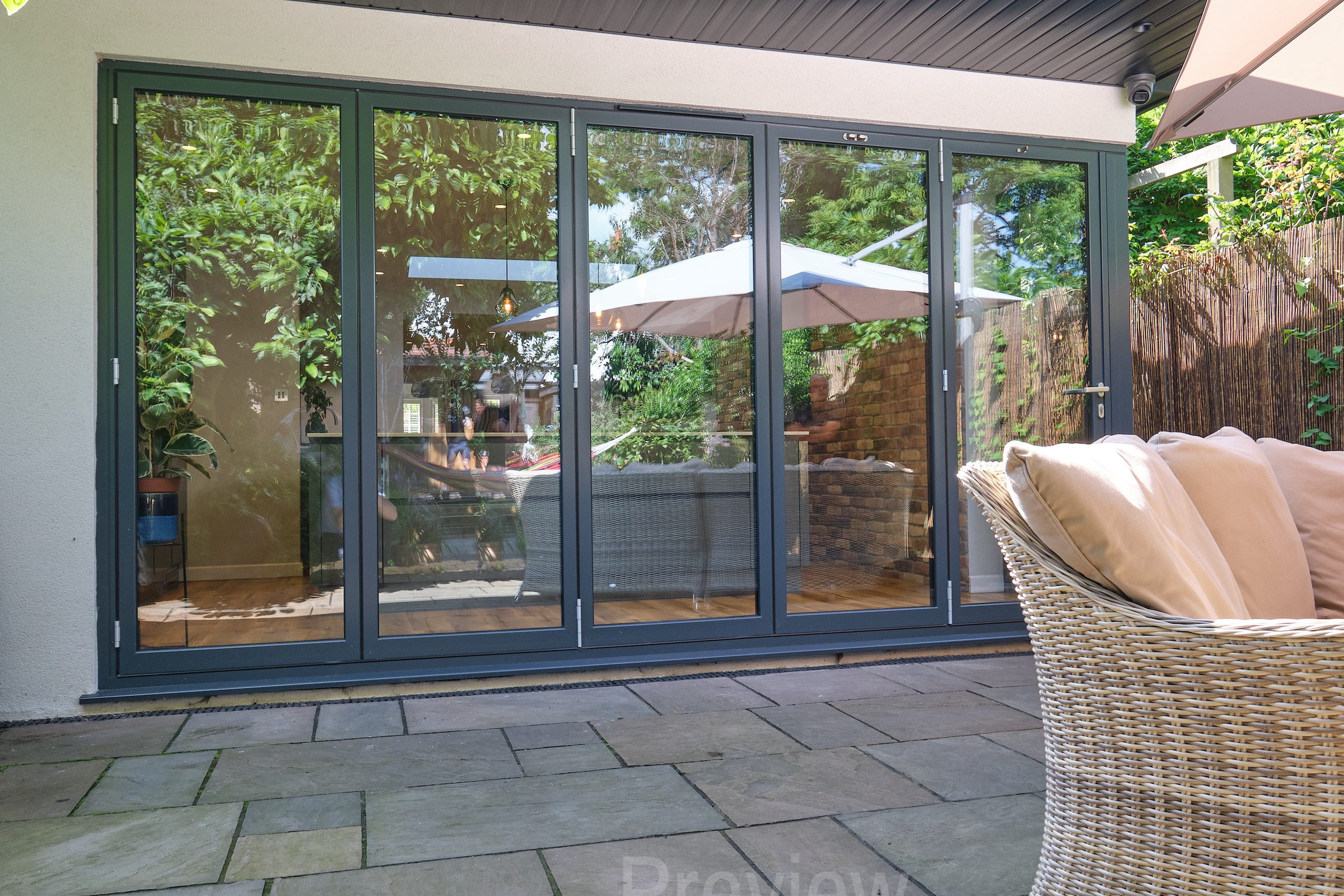It is mandatory for windows and doors to have trickle vents, whether going into new openings or when replacing your old windows. If you are confused about having trickle vents on windows or doors you are about to buy, get in touch for more information and details about window and door companies that can help with your glazing and ventilation requirements.
The information around trickle vents can confuse, and even some door and window installers may provide the wrong information. Here you’ll find all you need to know about trickle vents, when and where you need them, and why your home benefits from them too.
You can also read our article about how Part F of building regulations affects the installation of new doors and windows after June 2022.
What are trickle vents?

Trickle Vents or trickle ventilators are a component within a window or a door, situated at the upper part of the frame. Their purpose is to provide permanent ventilation into the room, even with a closed window. These vents allow a small amount of ventilation through the window at all times. They come either as permanent or a controllable version, opening and closing.
Above all, they’re designed to improve the quality of air in a room and hopefully a reduction in condensation.
Types of trickle vents available
For windows and doors, three different types of trickle vent are possible, depending on the product, the installation or the building:
- Fitted through the window frame itself or the opening sash
- Located on a separate frame attached to the top of the window
- Glass units with trickle vents mounted at the top
The claimed benefits of window vents
Current Building Regulations relating to background ventilation stipulate the use of trickle vents in new-build homes and extensions. Some window and door installers don’t mention the need for these at all, irresponsibly leaving the decision to the homeowner. However, the reasons for using them are convincing – and it all centres around our health and not damaging your home with moisture.
Modern materials, energy-saving and interior comfort mean today, we insulate our homes better than ever. Insulation is a good thing. Owners of older and poorly insulated buildings understand heat loss through walls and roofs without insulation or old single glazed windows and doors.
Thermal comfort, energy-saving, and reducing heat loss mean better all-round comfort. However, it also means better-sealed homes resulting in the air unable to escape and of poorer quality inside the room. This poor-quality air comes in several forms. CO2, candles, paint fumes, cooking and bathing and those rarely opening windows in their homes. All this adds to moisture, stale air, and having to deal with condensation.
Above all, poor air quality is known to affect general health and our homes are no exception.
Do trickle vents work?
Yes, they do. They provide continuous and discreet fresh air into the rooms at all times when left open. And there are numerous large companies specialising in these products.
They’re especially effective in rooms rarely used such as spare rooms. Bathrooms, kitchens, and toilets also benefit.
The fact is, the winter months mean our homes are less ventilated, and we spend more time in them and we often dry our clothes indoors. These small and unobtrusive window and door enhancements provide genuine benefits in providing controlled ventilation and fresh air into the rooms we use every day and those we don’t.
Trickle vents allow controlled ventilation and fresh air into habitable rooms, freshening the stale air. Keep your trickle vents open and they should help reduce moisture – they really do work. Our advice is to leave them fully open at all times.
Understanding when you need trickle vents
The information around the use of trickle vents is clear from reputable installers. It’s this simple.
For new build homes and extensions
Trickle vents are required in doors and windows to new build homes or new extensions unless there’s a suitable alternative method of ventilation meeting the current Building Regulations.
When replacing old windows and doors
If you’re replacing old windows and the outgoing windows have trickle vents, the new windows must also have trickle vents to a similar or better specification. The same applies to doors.
Trickle vents for new bifolding and sliding doors

You’ll see pictures of bifolding and sliding doors in new extensions. Some fitted with trickle vents, some without. What you should also know is some products don’t even come with the facility for trickle vents even though Building Regulations call for ventilation. Yet these doors are sold and installed every day.
There should be no issue with most of the bifolding and sliding door brands on the market having trickle vents. Some use an additional aluminium profile at the head, other brands are able to house the vent in the existing frame, without an add-on.
Our advice is ask the question and then double-check the answer with a reputable organisation such as the Glass and Glazing Federation offering correct advice.
If there is an alternative method of providing ventilation meeting Building Regulations, then trickle vents aren’t needed in the doors. In most cases, however, they’re required.
Myths and comments about window trickle vents
Some installers and those in the glazing trade can’t see the point of trickle vents. Their opinion is just that – an opinion. If any installer is telling you you don’t need them, not to bother, the Building Regulations are rubbish or anything whatsoever suggesting your new windows shouldn’t have trickle vents, they are giving you the wrong advice.
This article helps you understand why they’re used and the benefits of trickle ventilators in your new windows and doors. But let’s address some of the negatives you’ll hear about these essential components.
Trickle vents are unattractive
Aesthetics are subjective. So whether something is unattractive is down to the individual. What we can tell you is some installers are unaware of how slim and minimalist modern trickle vents are. A good window installer is already aware of these and sources their products from better manufacturers and suppliers, providing up-to-date products meeting today’s aesthetic requirements. Trickle vents are no exception.
With some models looking nearly invisible within a frame and also colour matched, the arguments around trickle vents being unattractive are quite weak with trickle vent products available today.
Compromised window thermal performance
It is true, window energy efficiency and U-Values aren’t calculated with trickle vents in the test models and simulations. But neither are bay windows or specific configurations and yet we still buy these.
This is a confusing message. Building Regulations are different for Energy Efficiency and Ventilation. The fact remains you need them in new build projects and when replacing old glazing already fitted with ventilators. Our view is the benefits of air quality in the room is important for general health and especially given how airtight we now make our homes.
Couldn’t you just open a window?
Yes, you can when the weather permits it and when it’s not a security concern on ground floor windows.
Trickle vents provide ‘background’ ventilation that’s consistent whilst keeping windows secure. Open windows provide ‘purge’ ventilation that’s only as effective as the time the window remains open. And if you leave your home to go on holiday, trickle vents are a benefit in keeping the home fresh.
Window vents let the heat out
People feel the draught and close the vent or think the room loses its heat. The purpose of trickle ventilators is providing a consistent flow of fresh air. Any cooling of the internal temperature in winter from a trickle vent is marginal. Keep your trickle vents open.
Your room is noisier
Another potentially incorrect statement. There are trickle vents for windows and doors with soundproofing as standard. A good installer should have the knowledge and ability to source these.
You simply don’t like trickle vents
Unless it is a listed building or in a conservation area, trickle vents are a legal requirement under the revised Building Regulations.

Trickle Vents vs ‘night-vent’ facility on windows
You may also be misled into thinking you don’t need trickle vents as most new aluminium and PVCu windows today have what’s called ‘two-stage locking’ or ‘night vent’ facility.
This involves partially opening a window vent around 10mm or more and then locking your window. This is not an alternative to ventilators in windows.
Windows on the ground floor should certainly not be left in the night vent position and the property unoccupied. The night vent facility is simply a feature enabling additional ventilation through the window without having it fully open. It is not intended to perform the role of the trickle ventilator.
- Whilst the window may be locked it’s not fully secure and actually more exposed to attack.
- This partially open facility does provide ventilation but does not work in the same efficient way.
- Lift and slide doors have similar functionality but not regular single or French Doors.
- It’s not an alternative solution to having a Building Regulations requirement for ventilators in window.
What to do if your windows are already fitted and you need trickle vents
Fitting trickle vents after the installation can be tricky as there are several factors to consider, but our advice here is as follows.
Your local window and door company probably doesn’t want to get involved with windows they’ve not sold or fitted. Our suggestion is to do a local search for a local double glazing repair and maintenance company. They are more likely to have come across this type of work and help you better.
Bear in mind new windows with trickle vents are designed around these and many need an additional profile at the head to accommodate the trickle vent. So it may not be possible to fit these if the top of your frame is too narrow. It might be possible to source a slim trickle vent for the head.
Remember when windows are made with trickle vents, holes are made in the frame to create the passageway in your windows for airflow. This is a professional job done on machining centres and can’t be done in situ. To get over this, many installers get over this in situ, by drilling a series of holes instead. This is normal and unavoidable. They’re hidden by the inside and outside housings of the vent.
Part F Building Regulations and trickle vents
From 15th June 2022, any newly installed windows and doors must be fitted with trickle vents. This is to do with Part F of the Building Regulations. Meeting Part F of the Building Regulations is not new – it’s actually been a requirement since 2010. However, the requirements of Part F have been updated.
The reason for improving building ventilation, and why Part F matters, is that modern windows and doors with today’s building methods and materials make our homes better insulated and consume less energy than ever before. The downside to this improved thermal comfort is that air quality suffers.
These new requirements require ventilation in windows and doors, helping to extract excess moisture and contaminated air, especially in kitchens or bathrooms. The airflow into the room must be refreshed with new airflow – precisely what trickle vents are designed to do. At the same time, they must help keep noise levels down, which modern trickle ventilation products also do.
As these requirements have changed recently, it is very important that you check with your installer to ensure that they are fitting products that comply with the new rules.
Conclusion
Remember, the rules regarding window ventilators are simple. All windows whether they are replacing old ones or for a newly built opening, now need trickle vents fitted.
All new build properties and extensions are required to have adequate background ventilation whether this is by window/door trickle ventilators, purge ventilation, or extraction.
If an installer is putting you off having trickle vents and bearing in mind they’re required by Building Regulations, this should be a warning sign as to whether that installer is right for you. Do further research, especially on patio doors and windows in new extensions.
You can also find out more about building regulations applicable to doors and windows generally, covering insulation, security, fire-resistance, protection and overheating.











